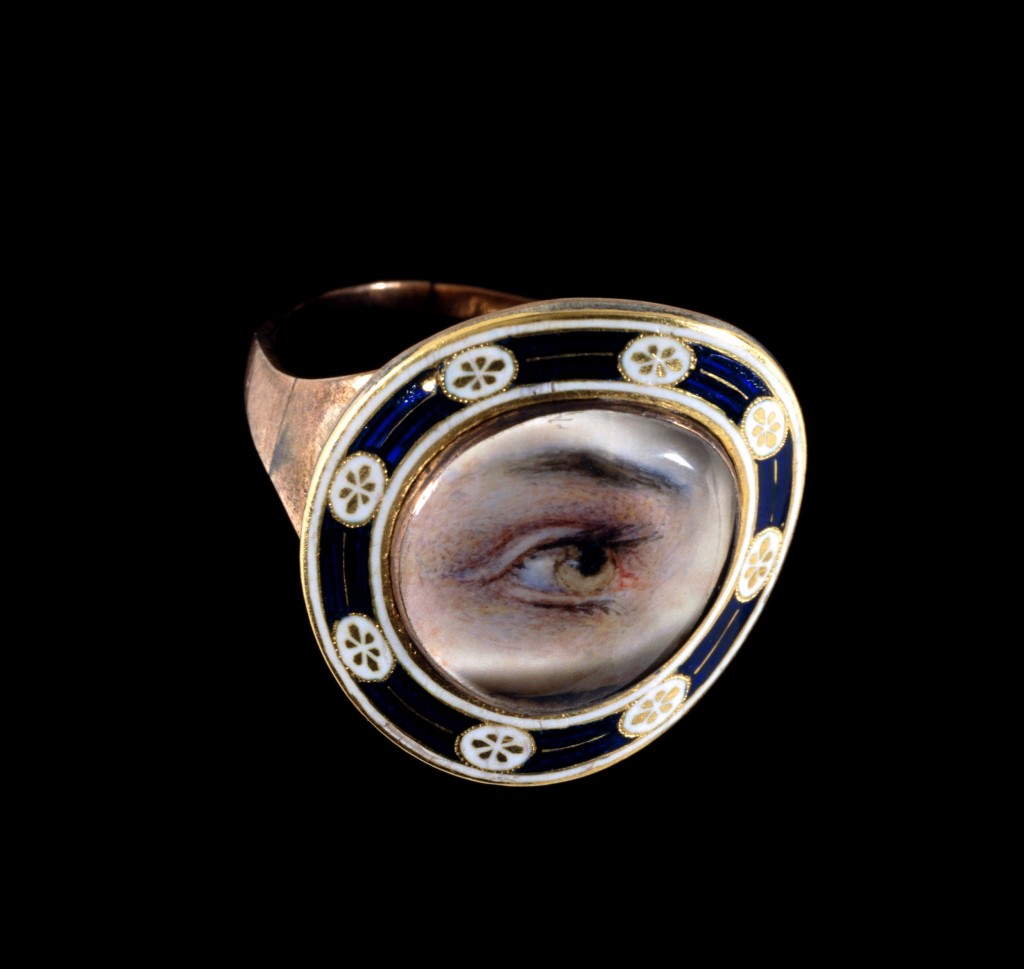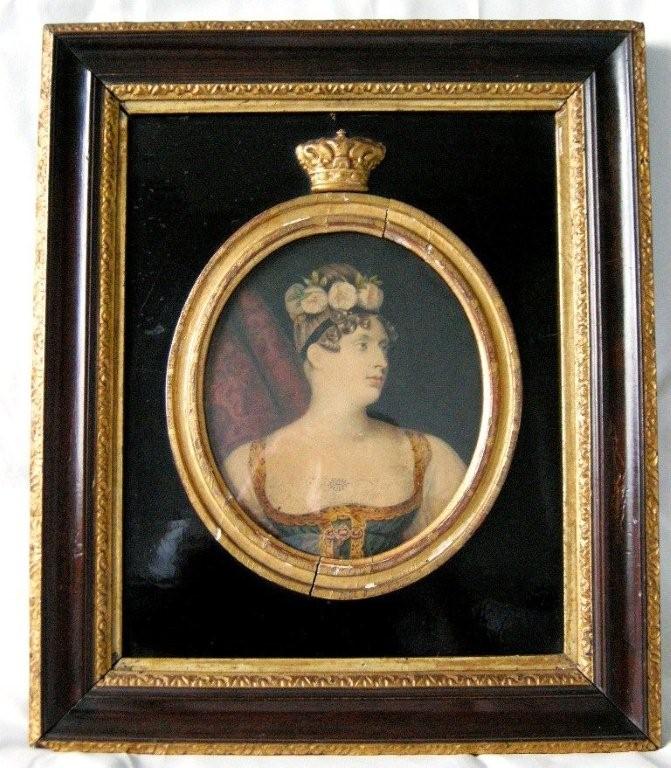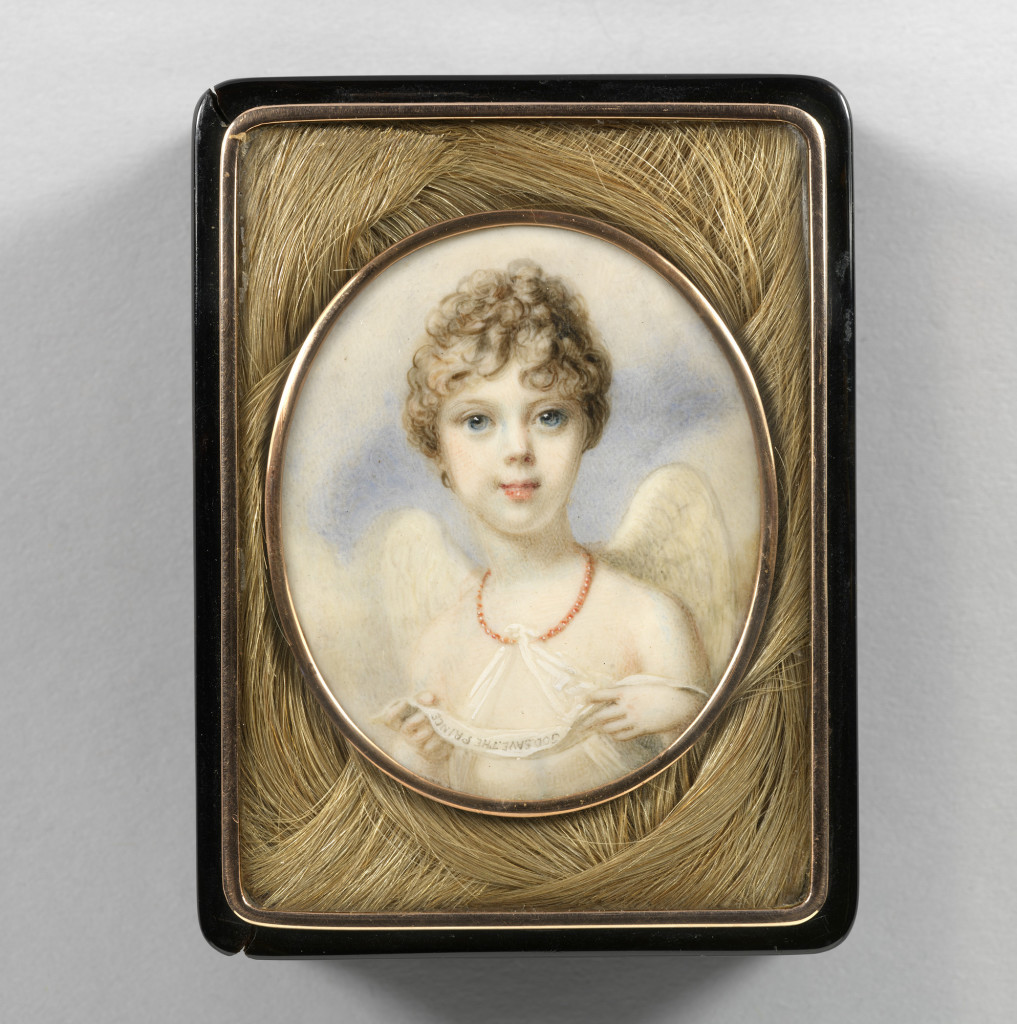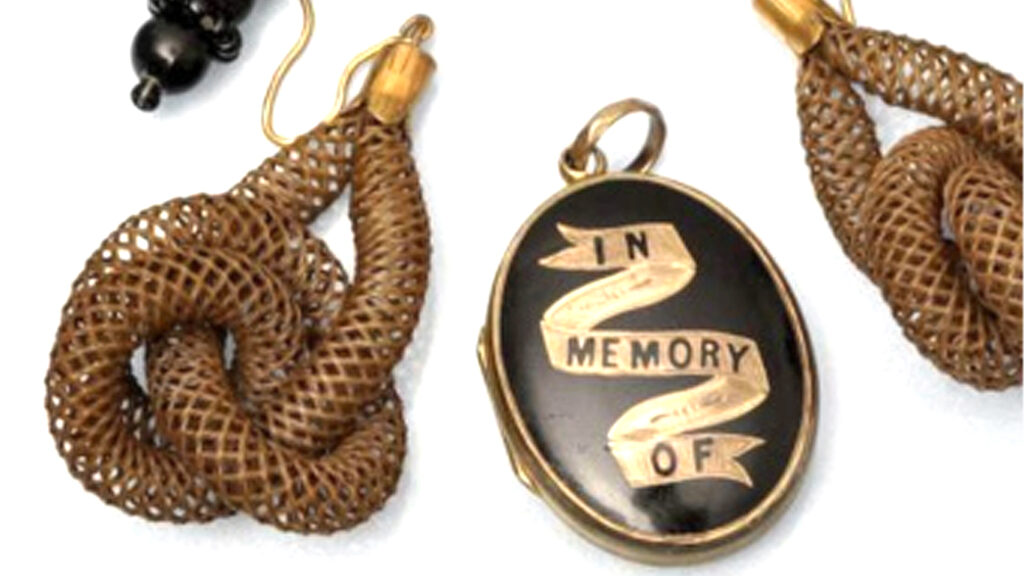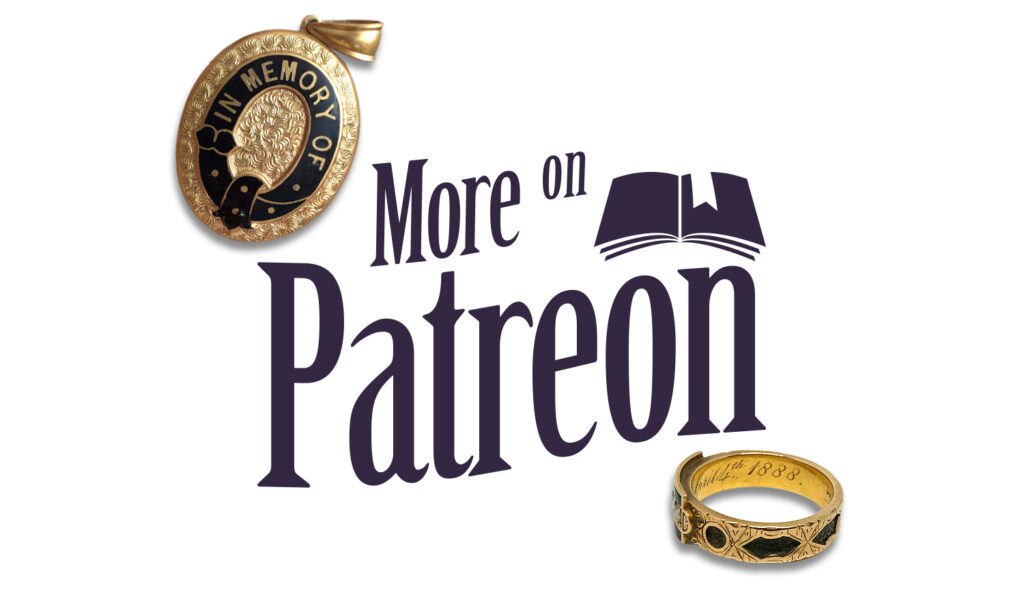Mourning Fashion & Jewels During George IV

Between the time of the Regency Act in 1811 and the reign of George IV from 1820 to 1830, society and mourning had become completely unified. The methods of mourning and the structures that had been put in place through Court had been well established by the growth of the Industrial Revolution and the permeation of the sentimental affectations in death and love had crossed through Europe in the Napoleonic Wars. Identity, in a time of mass transference and mobility, needed solidarity and it was in fashion and the respect given after death that one can give back to the country, crown and family.
This period was also the height of sentimentality, springing from the Neoclassical period, which put the sentimental influence back on the individual through the Enlightenment and exploited this in classical art. Depictions of allegorical statements and classical figures in love with ambiguous symbolism replaced the literal elements of love and death. George Augustus Frederick (1762 – 1830), the Prince Regent who would become George IV was no small influencer with this, funding much of the arts and generating fashion through sentimental quirks of fashion, such as the ‘Georgian eye’ miniatures, which were appropriated by the young rich.
New money and the ability to gain wealth through shipping and industry offshore, with the ability to bring that back to the United Kingdom, continued to change the rigid nature of expensive mourning/sentimental adoption, leading more more variations in styles. Personal values were amplified in the Neoclassical era (c.1760-c.1810), allowing for miniature portraits to capture the individual in a mourning or sentimental setting. With artists painting a Neoclassical ideal for a face, many paintings on ivory or vellum could be produced, with the pieces customised in hair colour and features for fast production. Mourning scenes were popular enough to be painted and then tailored with dedications by travelling miniaturists.
George was notorious for his hedonistic lifestyle, which was the direct antithesis to that of his pious father. At 21, his spending was exceptionally high, gaining a £60,000 grant from Parliament, as well as a yearly income of £50,000 from George III. With these funds, he gained possession of Carlton House and heavily refurbished it.
George’s love and relationship with Maria Fitzherbert was contentious for parliament, the public and his family life. As contentious as this relationship was, sentimental jewellery, such as eye portrait miniatures are traced to when the Prince of Wales wanted to exchange a token of love with Maria Fitzherbert, a Catholic widow of Edward Weld who died 3 months into their marriage. The court denounced the romance as unacceptable, though a court miniaturist developed the idea of painting the eye and the surrounding facial region as a way of keeping anonymity. The pair were married on December 15, 1785, but this was considered invalid by the Royal Marriages Act, as it had not been approved by George III. Fitzherbert’s Catholicism would have prevented any chance of approval, as George III was pious and Catholic challenge to the throne was still very recent. Maria’s eye portrait was worn by George under his lapel in a locket as a memento of her love. This was the catalyst that began the popularity of lover’s eyes. From its inception, the very nature of wearing the eye is a personal one and a statement of love by the wearer. Not having marks of identification, the wearer and the piece are intrinsically linked, rather than a jewellery item which can exist without the necessity of the wearer.
Exorbitant living put George into heavy debt, forcing him to move from Carlton house and into Fitzherbert’s residence. Knowledge of their marriage would have been incredibly disastrous to the country through the scandal, with parliament denying to marriage to the point of considering it slander. Parliament eventually granted George the funds to cover debts and improve Carlton House.
In 1788, George III fell ill and the notion of a Regency was raised, with Pitt the Younger suggesting that it was parliament’s right to choose the successor, rather than the Prince of Wales. A Regency Bill was raised in 1789, which limited the powers of the Prince of Wales to not grant peerage or sell property. Complications stemming from actual King’s consent to enforce a bill (something which was delegated to a group of the “Lords of Commons”. Before this bill could be introduced, George III recovered.
Family
But what about the impact of a child’s death on the family? How was this worn or displayed. The Neoclassical period of the 1760-1820 period revealed a personal nature of mourning that had not been captured to its fullest extent in previous early-modern times. The depiction of a couple mourning their child, and the symbols to identify the child with, became clearly displayed in popular jewels and fashion. The unmarried and virginal of society were shown in white enamel and clear depictions of love and mortality, but this was a continuity. Larger events, such as the death of a young member of the monarchy had the potential to drive mass mourning throughout culture and this was clearly evident in the mourning of Princess Charlotte, who died during childbirth in 1817. This event had a multiple effect to British society, as Charlotte was 21 years old and died during childbirth, elevating the concept of the death of the young and enforcing Court mandates around the stages of mourning that would resonate through the 19th century.
George IV had a contentious relationship with Charlotte as she grew older, with pressure to marry William, Hereditary Prince of Orange, a courtship that she ended. Eventually, she married Prince Leopold of Saxe-Coburg-Saalfeld, a relationship that lasted one and a half years.
Charlotte’s mother, Caroline of Brunswick, had restricted access to her after her birth, allowed only by the accompaniment of a nurse and governess. In 1794, Caroline and the Prince of Wales were engaged, but hadn’t met, George had pursued this marriage due to debt. Her critics, with their leaning towards the throne, were not kind to her appearance or behaviour, however she was equally critical of George, stating that George was ‘very fat and he’s nothing like as handsome as his portrait.’ She was also critical of his excesses.
Charlotte’s upbringing was praised by King George III who considered that her birth would bring Caroline and George back together, but the Prince of Wales was not so thrilled by the prospect of a daughter, rather than a son. George left a will stating that Caroline have no role in Charlotte’s upbringing and left her only one shilling.
Charlotte was christened Charlotte Augusta on the 11th of February, 1796, and became popular in the public’s eye. Breaking restrictions, her mother, Caroline, would be allowed by Charlotte’s careers to visit and even ride through London in a carriage, seen by the populace. Conflict between the Prince and Caroline continued through Charlotte’s childhood, however she remained close to George III. Upon George III’s affliction of ‘madness’, her father was sworn in before the Privy Council as the Prince Regent on February 6th, 1811. Political views, surrounding the Whigs, caused conflict in their relationship, placing restrictions from George upon her; both monetarily and socially. By 1813, George tired to enforce the wedding between Charlotte and William, the Hereditary Prince of Orange, a wedding frowned upon by the Princess of Wales and the public. George tired to involve her with even heavier restrictions, calling her to Cranbourne Lodge without being permitted to be seen by another other than the Queen, driving Charlotte to her mother and supporters. She was advised to follow her father’s orders and remained at Cranbourne Lodge until movement to Weymouth. By 1815, she had turned her affections to Prince Leopold of Saxe-Coburg. Following her father’s approval, an announcement was made in the 14th of March, 1816 to the House of Commons about their impending marriage. The two were married on the 2nd of May, 1816, to the great acclaim of the populace of London at 9pm.
Suffering a miscarriage in 1816, Charlotte remained in the social spotlight, yet under watch by the physician-in-ordinary, with another pregnancy announced in April 1817. On the 5th of November, 1817, Charlotte gave birth to a stillborn child and died soon after.
The death of Queen Charlotte was one of high cultural impact upon the United Kingdom, following on from her popular perception in the public eye. This cascading effect led to the production of memorial tokens of affection that were created to symbolise her loss.

In the same way that the culture created tokens for Horatio Nelson, Wellington and Napoleon, this was a society that had the means to create popular souvenir tokens for the event, the craftspeople to deliver them in high demand and increased production through discoveries in the Industrial Revolution.
However, regardless of the affectation, this was still a society in shock, Charlotte’s death fed an industry that demanded the tokens of mourning to show their love and appreciation for her and her child.
One of the most important reactions to Charlotte’s death, from a mourning perspective, were to the stage of mourning and the requirement of fashion. These requirements resonated throughout the 19th century and led to the height of the mourning industry. This was a culture with a high mortality rate and a culture that looked to the crown for the requirements of proprietary surrounding love and death. A culture that needed to follow the context of ordained indoctrination in the affectations of fashion which established the stages of mourning. Everything from tea services, prints, poems and tea services were created for Charlotte, even with a petition to St George’s Chapel erecting a large marble structure for her. This ranged from levels of society, with Lord Holland noted that there were “signs of mourning on their persons” to the postboys and turnpike men that he passed.
It is indeed important that Charlotte’s passing affected the concept of mourning throughout Victoria’s reign. It took the identity of an entire culture and led it towards a new standardisation of fashion that led to a requirement of mourning and enhanced an industry that utilised mourning as a source of income. Through being the death of a child, the impact resonates even stronger than just the timely passing of a monarch; this Princess and future heir to the throne died. If ever there was a connection to what ‘memorial’ jewellery stands for, this is it. It connects a society and is worn and displayed as such.
George III fell ill once more in 1810, moving parliament to follow the same process as the previous Regency Act, with the Lords Commissioners granting Royal Assent to the bill which would become the Regency Act of 1811. On the 5th of February, 1811, the Prince of Wales became the Prince Regent, with his power reduced for the period of one year.
As with monarch succession and the focus upon the aristocracy to emulate Court style, the Regency era is known for the Prince of Wales spending in the arts. The Brighton Pavillion was designed as a monument to the influences of the time, from architect John Nash’s exterior Indian-Chinese design and Frederick Crace’s interior with Islamic elements, it is a blend of exotic style with the mainstream classical elements.

Catholic emancipation became the major topic of contention in parliament after George’s ascension, however much of the decision making was left to ministers. War with Napoleon continued during this time, leading to his defeat in 1814 through an anti-French alliance Russia, Austria and Prussia. In the same year, the Treaty of Ghent was ratified, leading to a peace treaty with the United States from the War of 1812 and Hanover was made an independent kingdom.
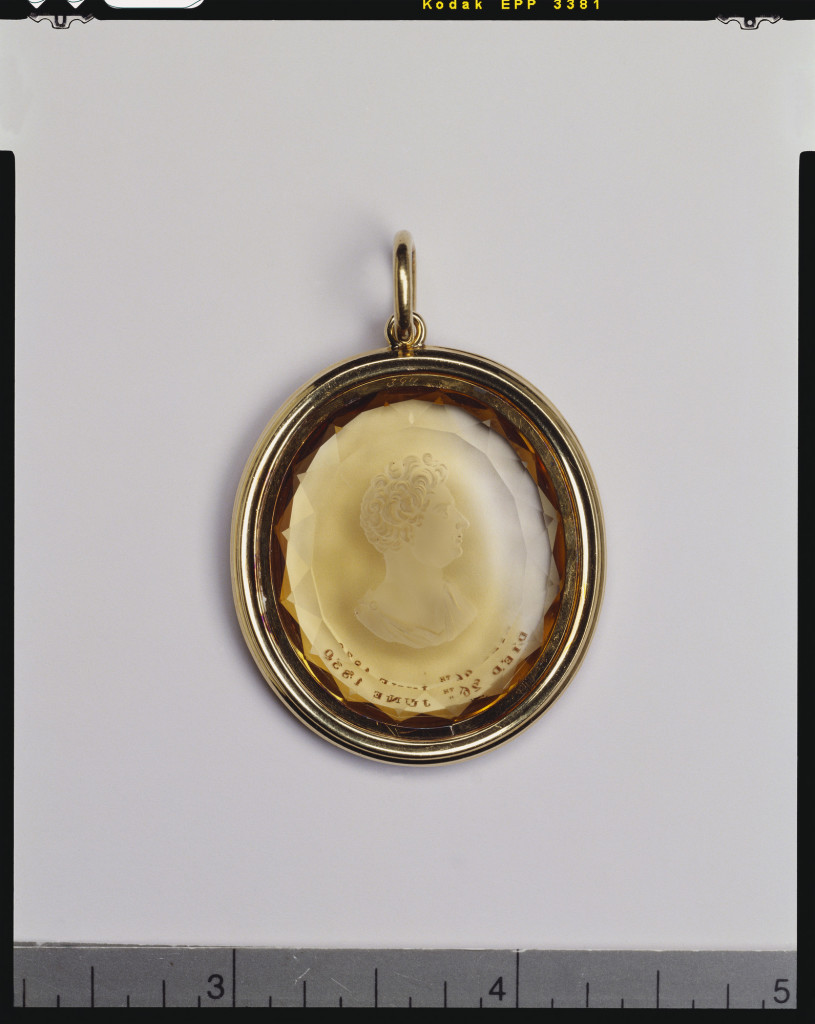
In 1820, George ascended the throne upon the death of his father, then aged 57. The rift between Caroline was so great that he refused to acknowledge her, taking her name from the Book of Common Prayer and insisting that no other foreign monarch saw her as queen consort. They had been living apart, with her return being driven by George’s coronation on the 19th of July, 1821 (costing £243,000).
George actively worked to divorce Caroline. Due to the potential scandal over revealing his promiscuous behaviour, advisors argued against an annulment of their marriage, however the Pains and Penalties Bill was maintained by George. This bill would have declared that Caroline committed adultery, granting the King a divorce. Essentially, this acted as a trial of the queen, with the House of Lords and Commons being the judge and jury. if the bill was debated. Narrowly, the bill was passed, but it was not favourable in the public and was withdrawn before it could be debated. Caroline subsequently died on the 7th of August, 1821.
The remaining years of George’s reign were with minimal influence in politics, other than influencing opinion over Catholic equality in law. George reigned from Windsor Castle and his health declined through his excess. His weight was already a topic of ridicule in public (dubbed the ‘Prince of Whales’, as he weighed 111kg in 1797). Suffering from gout and indulging in alcohol and food, in 1820, his corset measured 50 inches. By 1830, George’s pains had left him bedridden and he turned to religion over his previous deeds. He died of gastrointestinal bleeding, a large tumour attached to the bladder and an enlarged heart with calcified heart valves and fatty deposits. His younger brother, William, would next take the crown.





